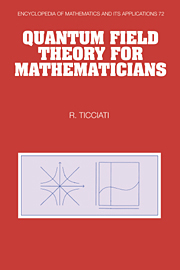Book contents
- Frontmatter
- Contents
- Preface
- Introduction
- 1 Relativistic Quantum Mechanics
- 2 Fock Space, the Scalar Field, and Canonical Quantization
- 3 Symmetries and Conservation Laws
- 4 From Dyson's Formula to Feynman Rules
- 5 Differential Transition Probabilities and Predictions
- 6 Representations of the Lorentz Group
- 7 Two-Component Spinor Fields
- 8 Four-Component Spinor Fields
- 9 Vector Fields and Gauge Invariance
- 10 Reformulating Scattering Theory
- 11 Functional Integral Quantization
- 12 Quantization of Gauge Theories
- 13 Anomalies and Vacua in Gauge Theories
- 14 SU(3) Representation Theory
- 15 The Structure of the Standard Model
- 16 Hadrons, Flavor Symmetry, and Nucleon-Pion Interactions
- 17 Tree-Level Applications of the Standard Model
- 18 Regularization and Renormalization
- 19 Renormalization of QED: Three Primitive Divergences
- 20 Renormalization and Preservation of Symmetries
- 21 The Renormalization Group Equations
- Appendix
- References
- Index
18 - Regularization and Renormalization
Published online by Cambridge University Press: 31 October 2009
- Frontmatter
- Contents
- Preface
- Introduction
- 1 Relativistic Quantum Mechanics
- 2 Fock Space, the Scalar Field, and Canonical Quantization
- 3 Symmetries and Conservation Laws
- 4 From Dyson's Formula to Feynman Rules
- 5 Differential Transition Probabilities and Predictions
- 6 Representations of the Lorentz Group
- 7 Two-Component Spinor Fields
- 8 Four-Component Spinor Fields
- 9 Vector Fields and Gauge Invariance
- 10 Reformulating Scattering Theory
- 11 Functional Integral Quantization
- 12 Quantization of Gauge Theories
- 13 Anomalies and Vacua in Gauge Theories
- 14 SU(3) Representation Theory
- 15 The Structure of the Standard Model
- 16 Hadrons, Flavor Symmetry, and Nucleon-Pion Interactions
- 17 Tree-Level Applications of the Standard Model
- 18 Regularization and Renormalization
- 19 Renormalization of QED: Three Primitive Divergences
- 20 Renormalization and Preservation of Symmetries
- 21 The Renormalization Group Equations
- Appendix
- References
- Index
Summary
Presenting the principles and procedures for identifying the character of a divergent integral with a view to systematically canceling the divergences that arise in perturbation theory.
Introduction
This chapter begins Part 5, the last part of the book. As we have now pushed tree-level applications as far as we usefully can, Part 5 is concerned with higher-order corrections in theory and in practice. Chapter 18 sets the stage for the investigation by providing a standard regularization for Feynman integrals. Chapter 19 presents a detailed account of renormalization as it applies to the simplest divergences in QED. Chapter 20 goes into the theory of renormalization; it presents the forest formula for systematically matching counterterms with divergences and the proof that renormalization preserves gauge invariance in theories whose fermion multiplets pass the consistency test of Theorem 13.6.8. Finally, Chapter 21 brings the book to completion with a careful account of the renormalization group.
Many fundamental loop diagrams give rise to divergent integrals. The first step in defining higher-order corrections is to express divergent Feynman integrals as limits of convergent integrals, and the second step is to arrange for systematic cancellation of divergences. As we saw in Chapter 10, such cancellation can generally only be organized by putting similar divergences in the coefficients of the bare Lagrangian density, or equivalently in the coefficients of the counterterms.
- Type
- Chapter
- Information
- Quantum Field Theory for Mathematicians , pp. 532 - 563Publisher: Cambridge University PressPrint publication year: 1999



